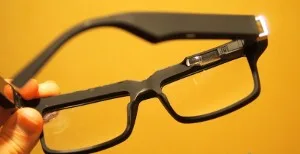Ernesto Martinez, Head of Wearable Computing at Kopin, delivered a talk entitled Wearables: Enabling Human Augmentation during the Wearable-Flexible Market Focus Conference at SID Display Week. The speaker noted that Kopin, the venerable microdisplay maker, is now a thirty year old company. Dr. Martinez made reference in his talk to his prior work at MIT developing bionic prosthetic limbs as work enabling human augmentation. He clearly now also sees a case going forward for augmenting the human visual system using wearable displays.
Martinez views wearable technology as being “personal and portable” and moving beyond a data interface to address the transition from “restoration to augmentation”. He noted that the “wearables market is becoming complex” in both hardware and in applications. Calling on his prior experience with prosthetics and drawing a fashion related conclusion, he observed that “(artificial) legs have advanced to the point that users show off their prosthetics”. He addressed the “smart eyewear” user interface challenge citing his approach relying on combinations of speech, favorable ergonomics and information display.
Dr. Martinez also referenced Kopin’s compact “Pupil” near to eye (NTE) display module that enables an eyeglass-style wearable display (photo below) in an at least somewhat fashionable eyeglass frame. He pointed out that the compact near eye display design addresses the tension existing with current designs between “smart fashion versus function”. As did other speakers in this wearables conference session, Martinez noted the proliferation of models (stock keeping units, SKUs) among eyewear marketers with introductions of as many as 1500 designs in each of 3 seasons in a fashion design cycle year.
 Source: Kopin
Source: Kopin
The panel session discussion and question and answer session at the end of the first wearables session provided an opportunity for additional input from Kopin’s Martinez. When referencing Google Glass, one speaker noted that the presence of a camera in the wearable device was intrusive and ultimately resulted in a barrier to popular adoption of the device. Martinez remarked that Google Glass was not a failed project saying that its provision of notifications was a strong point.
Martinez went on to say that Apple’s taptic engine was also well suited for notifications – more so than the conventional haptic buzzing used in some devices. On the other hand, Martinez pointed out that humans have evolved means to communicate primarily based on vision and hearing and not primarily based on touch or haptic information. While Dr. Martinez’ talk addressing wearables and enabling human augmentation was suggestive of future directions for the industry, and referenced some interesting technology, there were no examples of product concepts or designs that substantially advance toward that lofty goal. – Phil Wright

